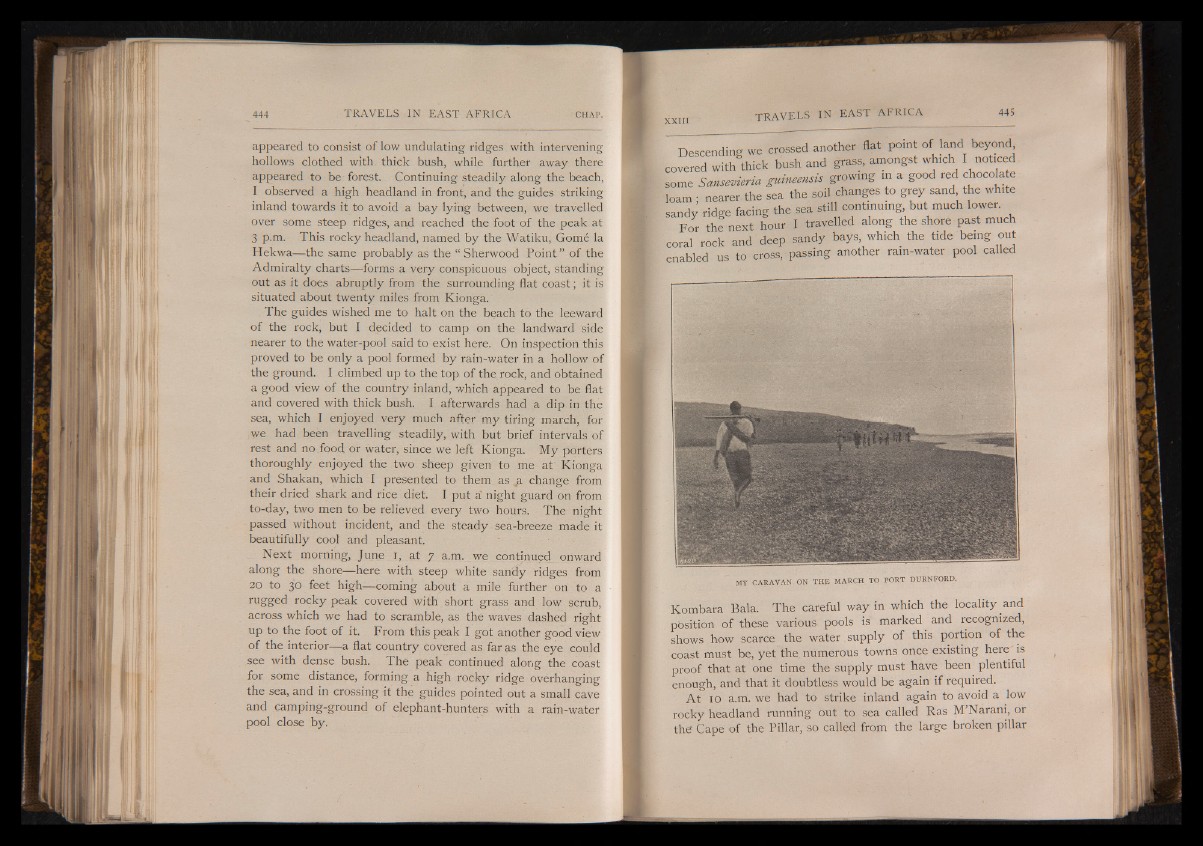
appeared to consist of low undulating ridges with intervening
hollows clothed with thick bush, while further away there
appeared to be forest. Continuing steadily along the beach,
I observed a high headland in front, and the guides striking
inland towards it to avoid a bay lying between, we travelled
over some steep ridges, and reached the foot of the peak at
3 p.m. This rocky headland, named by the Watiku, Gom6 la
Hekwa— the same probably as the “ Sherwood Point” of the
Admiralty charts— forms a very conspicuous object, standing
out as it does abruptly from the surrounding flat coast; it is
situated about twenty miles from Kionga.
The guides wished me to halt on the beach to the leeward
of the rock, but I decided to camp on the landward side
nearer to the water-pool said to exist here. On inspection this
proved to be only a pool formed by rain-water in a hollow of
the ground. I climbed up to the top of the rock, and obtained
a good view of the country inland, which appeared to be flat
and covered with thick bush. I afterwards had a dip in the
sea, which I enjoyed very much after my tiring march, for
we had been travelling steadily, with but brief intervals of
rest and no food or water, since we left Kionga. My porters
thoroughly enjoyed the two sheep given to me at Kionga
and Shakan, which I presented to them as jl change from
their dried shark and rice diet. I put a' night guard on from
to-day, two men to be relieved every two hours. The night
passed without incident, and the steady sea-breeze made it
beautifully cool and pleasant.
Next morning, June i, at 7 a.m. we continued onward
along the shore— here with steep white sandy ridges from
20 to 30 feet high-—coming about a mile further on to a
rugged rocky peak covered with short grass and low scrub,
across which we had to scramble, as the waves dashed right
up to the foot of it. From this peak I got another good view
of the interior— a flat country covered as far as the eye could
see with dense bush. The peak continued along the coast
for some distance, forming a high rocky ridge overhanging
the sea, and in crossing it the guides pointed out a small cave
and camping-ground of elephant-hunters with a rain-water
pool close by.
Descending we crossed another flat pom of land beyond
covered with thick bush and grass, amongst which I noticed
some Sansevieria guineensis growing in a good red chocolate
loam ; nearer the sea the soil changes to grey sand the white
sandy ridge facing the sea still continuing but much lower.
For the next hour I travelled along the shore past much
coral rock a n d deep sandy bays, which the tide being out
enabled us to c r o s s , passing another rain-water pool called
MY CARAVAN ON THE MARCH TO PORT DURNFORD.
Kombara Bala. The careful way in which the locality and
position of these various pools is marked and recognized,
shows how scarce the water supply of this portion of the
coast must be, yet the. numerous towns once existing here is
proof that at one time the supply must have been plentiful
enough, and that it doubtless would be again if required.
A t 10 a.m. we had to strike inland again to avoid a low
rocky headland running out to sea called Ras M’Narani, or
the Cape of the Pillar, so called from the large broken pillar